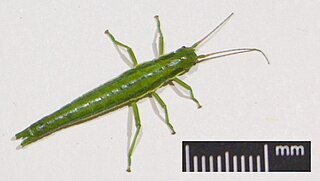
The Virgin Mountains are a mountain range of the northeastern Mojave Desert, located in Clark County, southeastern Nevada and Mohave County, northwestern Arizona.

Timema is a genus of relatively short-bodied, stout stick insects native to the far western United States, and the sole extant member of the family Timematidae. The genus was first described in 1895 by Samuel Hubbard Scudder, based on observations of the species Timema californicum.

Allium nevadense is a species of wild onion known by the common name Nevada onion. It is native to the western United States where it grows in sand and rocky soil at elevations of 1400–1700 m. The species is widespread in Utah, Nevada and southern Idaho, and has been reported also from southeastern California, northwestern Arizona, western and central Colorado and eastern Oregon.

Lepidium montanum is a species of flowering plant in the mustard family known by the common names mountain pepperweed, mountain peppergrass, mountain pepperwort, and mountain pepperplant. It is native to western North America from Oregon to Montana to northern Mexico, where it can be found in a number of habitats, often on salty or gravelly soils. There are several varieties, many of which are difficult to distinguish.

Lomatium nevadense is a species of flowering plant in the carrot family known by the common name Nevada biscuitroot. It is native to the western United States and northern Mexico, where it is known from several different habitat types, including sagebrush and woodlands. It is a perennial herb growing up to about 45 centimeters tall from a taproot. The leaves are up to about 16 centimeters long, their blades divided into many oblong pointed segments. The inflorescence is an umbel of white or cream flowers.

Alexiidae is a family of beetles, in the suborder Polyphaga, formerly included within the family Cerylonidae. Alexiidae are very small, almost half spherical beetles with clubbed antennae. They are fungivores found in leaf litter or decaying wood. The family contains the single genus Sphaerosoma with the following species:
Ribes nevadense is a species of currant known by the common names Sierra currant and mountain pink currant.

Timema douglasi is a stick insect native to northern California and southern Oregon. It was first identified in 1996 as a specialist feeder on old-growth Douglas fir. It is one of five parthenogenetic species of Timema.
Evergestis mundalis is a species of moth in the family Crambidae described by Achille Guenée in 1854. It is found in France, Spain, Italy and Greece. In the east, the range extends to Armenia.

Timema poppense, the "Pope Valley timema", is a species of walkingstick in the family Timematidae. It is found in California, and originally described from a nature reserve in the Pope Valley.

Timema bartmani, or Bartman's timema, is a species of stick insect in the family Timematidae. It is found in North America.
Timema ritense, the Santa Rita timema, is a species of walkingstick in the family Timematidae. It is found in North America. The species was originally spelled "ritensis", but this spelling did not match the gender of the genus Timema, and therefore has undergone a mandatory change following ICZN Article 31.2.

Timema genevievae, or Genevieve's timema, is a species of walkingstick in the family Timematidae. It is found in North America.

Timema californicum, the California timema, is a species of walkingstick in the family Timematidae. It is found in North America.

Timema cristinae, or Cristina's Timema, is a species of walking stick in the family Timematidae. This species is named in recognition of the person who first found and collected it, Cristina Sandoval. It is found in North America, in a small region of southern California, US. T. cristinae is one of the smallest species of stick insects. They are flightless, and feed on the shrubs on which they live.
Timema boharti, or Bohart's timema, is a species of walkingstick in the family Timematidae. It is found in North America.
Timema podura, the Sierra Nevada timema, is a species of walkingstick in the family Timematidae. It is found in North America.

Timema chumash, the chumash timema, is a species of walkingstick in the family Timematidae. It is found in North America.
Epilobium nevadense is a rare and vulnerable species of flowering plant in the willowherb family Onagraceae. It is known from a few scattered populations in mountain ranges in Nevada, Utah, and northwestern Arizona. It grows on talus slopes composed of either volcanic or limestone origin from 5200–9000 feet in elevation.

Timema shepardi, Shepard's Timema, is a stick insect native to northern California. It was first identified in 1999. It is one of five parthenogenetic species of Timema.












